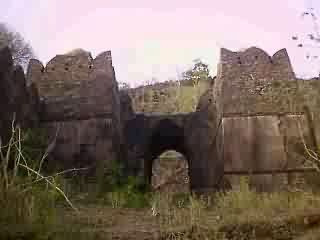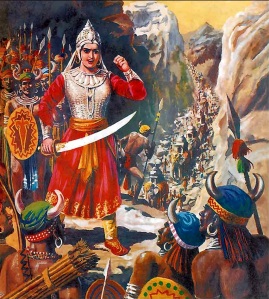Videha, often erroneously referred as Mithila, which was actually the capital city, is one of the oldest kingdoms of India. It has been in the collective conscience of Indians mostly due to its most popular king Seeradhwaja, the 21st Janak of Videha, whose daughter Sita married Prince Rama of Kosala.

According to Vishnupurana, Nimi was the first king of Videha whose capital was Jayantapura (modern Janakpur, Nepal). He was cursed by sage Vasistha to take an incorporeal form but owing to the resultant anarchy that engulfed Videha henceforth several sages had to gather and implore the bodiless Nimi to take a human form and this was how Mithi was born (mithi means soil) who after much wandering settled across river Sadanira (Gandak) and established his capital at Mithilapuri (modern Janakpur, Nepal). Since Mithi was born of his father’s body he (and the later kings) was also called Janak and the region varyingly came to be known as Janakpur or Mithilapuri or just Mithila. It was a dynasty that ruled the area between the foothills of the Himalayas and the river Ganges till about 7th century BC when the last Janak (52nd) Kriti was dethroned by the public for his atrocities. Henceforth, the area came under various rulers and formed a part of various kingdoms including those of the Licchavi, Magadha, Shishunaga, Nanda, Maurya, Shung, Gupta, Pal, Sena, Karnat, etc who had different capitals for their kingdoms.

In 1326, Firoz Shah Tughlaq attacked Mithila and the last king of the Karnat dynasty, Hari Singh Dev fled to Nepal. In 1353, Firoz appointed Kameshwar Thakur from Oini village (Samastipur, Bihar) as karad raja (tax paying king) but since he was of scholarly nature he was inefficient in maintaining an army and collecting taxes for the emperor and was thus replaced by his son Bhogishwar Thakur. They were a line of 14 kings and 1 queen who ruled Mithila till 1526 under the tutelage of the Tughlaks and as the Oinwar dynasty (named after the village Kameshwar hailed from).

Sikander Lodhi made his son-in-law Alauddin the ruler of Mithila in 1526 who ruled incompetently over the land till 1577 until Akbar established his control and firmly rooted his position as the Mughal Emperor of India. Akbar knew that only a Brahmin could rule over Mithila and thus he summoned rajpandit Chandrapati Thakur of Garha-Mandla and made his son, Mahesh Thakur, the caretaker of Mithila.

The family and descendants of Mahesh Thakur gradually consolidated their power in social, agrarian, and political matters and came to be regarded as kings with their capital at Rajgram (Madhubani district) which was later moved to Darbhanga by Nirpat Thakur. They bought land from local people and became known as a Khandavala family (the richest landlord). The family was not regarded as kings by the British Raj but they were allowed to use the prefix Maharaja, and later Maharajadhiraj, by the British. There is no documentation for this as it was a verbal commitment. Although the British never granted them formal status as a ruling princely state, they had all the trappings of a princely state with an area of 6200 sq km.

List of Kings of Khandavala Dynasty (1577 – 1947)
Raja Mahesh Thakur (1577 to 1558)
Raja Gopal Thakur
Raja Parmanand Thakur
Raja Subhankar Thakur
Raja Purushottam Thakur (1607 to 1623)
Raja Narayan Thakur (1623 to 1642)
Raja Sundar Thakur (1642 to 1662)
Raja Mahinath Thakur (1662 to 1684)
Raja Nirpat Thakur (1684 to 1700
Raja Raghu Singh (1700 to 1736)
Raja Bishnu Singh (1736 to 1740)
Raja Narendra Singh (1740 to 1760)
Raja Pratap Singh (1760 to 1776)
Raja Madho Singh (1776 to 1808)
Maharaja Chhatra Singh Bahadur (1808 to 1839)
Maharaja Rudra Singh Bahadur (1839 to 1850)
Maharaja Maheshwar Singh Bahadur (1850 to 1860)
Maharaja Lakshmeshwar Singh Bahadur (1860 to 1898)
Maharaja Rameshwar Singh Bahadur (1898 to 1929)
Maharaja Kameshwar Singh Bahadur (1929 to 1947)

Lakshmeshwar Singh Bahadur was a very prominent figure among the last of rulers of Mithila. He and the forthcoming rulers were benevolent donors to many socially important changes in India and diligently worked for the betterment of the society in and around their area of influence. They donated much of their palaces for starting up universities and medical colleges (in pictures). Though they maintained their loyalty to the British Raj they were instrumental in financing the Congress party at critical junctions.

Present History
Mithila as of now is a part of the Indian state of Bihar and the surrounding terai area of Nepal and comprises the areas of Janakpur, Sirha, Rajbiraj, Biratnagar in Nepal and Bettiah, Muzaffarpur, Sitamarhi, Samastipur, Madhepura, Darbhanga, Madhubani, Supaul, Saharsa and parts of Purnia and Tirhut division of Bihar in India. The economy is mostly agrarian and the area is prone to floods and is one of the poorest regions in India. The region is though native to one of India’s foremost forms of painting, Madhubani, which is said to have emerged from the time of Sita’s marriage to Rama. The government, of late, has been promoting it as an important artwork of Indian heritage. The art form recruits heavily from Hindu motifs besides courtly symbols, marriages and nature. No space is left empty and it is highly colorful. One of Hindu marriage’s most important rituals, mostly in the Gangetic plains, the drawing of a Kohbar, that usually has images of sexual pleasure and procreation is a product of Madhubani painting.

The people of Mithila are mostly Brahmins and deeply rooted in rich rituals and traditions. They are peace loving people who live in large families and highly respectful towards their parents. Most of the Hindu festivals are celebrated with much pomp and show with the mundan ceremony being very prominent compared to other parts of Hindu India. They mostly speak Maithili (included in the 8th Schedule of Indian Constitution in 2003 as one of the Official Languages of India) as their native language with Angika, Bhojpuri, and Hindi also understood and spoken by many. Sanskrit and English is also quite popular but used by a niches section of the population. Maithili is often considered to be one of the sweetest languages in India besides Bengali and Calcutta University was one of the first institutes to recognize Maithili as early as 1917. The Sahitya Academy, an organization dedicated to the promotion of Indian literature, officially accepted Maithili in 1965.










